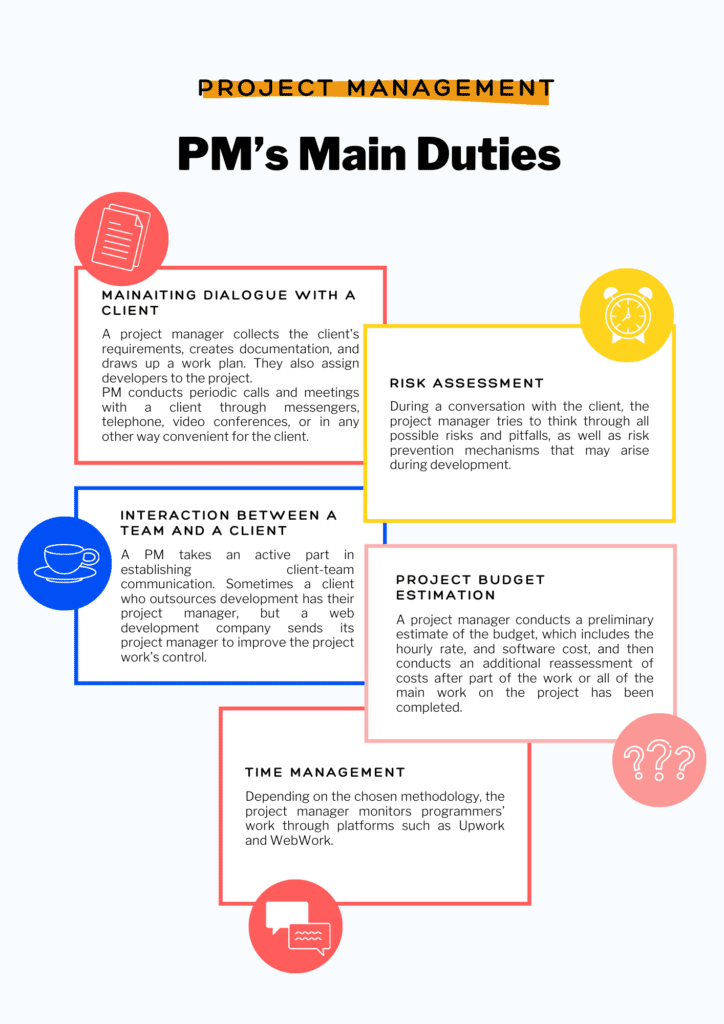In the modern IT industry, which is constantly and rapidly developing, the main key to successful web solution development is effective project management. It depends on how quickly, thoughtfully, and comfortably the entire work process will be carried out on a web solution that will be quite competitive. No wonder 46% of organizations believe that project management is vital for their activities.
What exactly is the importance of project management, what are the responsibilities of PM and what are the main approaches – we’ll discuss it in a new blog post. We will also reveal in detail why project management skills are necessary for the successful operation of enterprises in modern business.
What Is Project Management and Why It Matters
Project management is a set of skills and knowledge aimed at organizing, planning, and managing tasks within the company. In IT companies, the project manager collects requirements for the client’s web solution, creates documentation, draws up a further work plan for developers, and monitors how successfully the work has been completed and whether the team adheres to the given deadlines and budget.
Speaking about PM’s responsibilities in detail, they also include:

Explaining Agile, Waterfall, and Scrum
Among the project management approaches, the following are usually distinguished: Waterfall, Agile, and Scrum. Waterfall is an approach where a programmer develops the project strictly in order, clearly from the first section to the last. And until developers reach a certain section with features on which the work of the already made feature depends, part of the functionality won’t work completely.
Agile and Scrum are more flexible approaches to web development. Using these approaches, the project manager plans a sprint of at least two weeks with the tasks, that a team should accomplish in that sprint. When the sprint comes to an end, a team looks at the result and checks which tasks they managed to do, and which tasks took more or less time. If a development team does not have time to complete the assigned task on time, they find out the reasons for the failure, draw conclusions, and move the task to the next sprint.
The main difference between Agile and Waterfall is that the Agile approach allows a developer to jump between sections of the project to develop it more holistically. Any project has a feature or function in one section of the project that is related to another function or feature from another section. A PM can plan the sprint for a developer who can simultaneously develop project features from completely different sections.
“For example, during the first chapter development, you need to make a feature from the fifth chapter to make another feature from the first one work. We can develop an interdependent feature, and in this way, the feature from the first section will work. That is, we will not need to wait for the programmer to reach the fifth section to develop this feature. We can jump right in, make the necessary functionality, and the primary feature will work for us”, said Pavel Moroz, TuneLab CEO.
In the Agile methodology, hourly tracking is the most suitable, because that allows you to make a better estimation of performed work and its cost. Meanwhile, the sprint estimate may not exactly and objectively determine the amount of the same payment.
Decoding Project Management Software and Tools
The most common tools for project management are Jira, Upwork, and WebWork. Using Jira, a PM can see and create a convenient plan for further work with the Kanban board. So they can see which tasks are currently in action, which have been completed, and which developers have not yet taken up. Meanwhile, how Upwork and WebWork allow you to track a developer’s working time.
In addition, Upwork is actively used as a tool for finding clients and further communication with them. To maintain further communication with the client, PM uses e-mail, Slack, WhatsApp, and other messengers at a client’s request. They can use Google Meet, Zoom, and other video conferencing platforms for video conferences and presentations of finished parts or a completed project.

Unconventional Situations in Project Management
When clients come to an IT company to order a web solution, they usually have a clear understanding of what their project should look like, with relevant documentation in hand. But sometimes there are non-standard cases in project management a developer team should resolve.
A client’s lack of documentation is one of such non-standard cases. This client usually only has a design and a general idea. Project managers themselves write the documentation, develop all the workflows, and inform a client this will be a separate type of service. After the discussion and the documentation approval, a company discusses with a client what will they have on the site, how it will work, and how much it will cost them. Then developers can start writing code.
Another example of a non-standard situation is the client’s request for new features in the web solution which is already in development. TuneLab project manager Maksym Cherniuk, who heads one of the new projects, shared a similar experience. According to him, they finished the project’s design and developed the backend. And now this backend is being overwritten to introduce a new feature into the project that was not included initially.
“Let’s assume we agreed on a certain amount of work with a certain estimate. We are working, but in the process, a client said: “I want to have another new feature. I didn’t see it, I just made it up. I don’t have any references, so please arrange it for me.” We tell him: “Okay, since we don’t have any references, we can’t give a preliminary time estimate now. We will now take a week to sit down and discuss this with the team and the designer. We’ll discuss the functionality and create its mockup. We’ll give a preliminary estimate of how long it will take us to make this design functional to write the backend for it. And we will give it to you.” – said Cherniuk.
Also, the project development time may depend on the level of employment of the developer himself. The load from different projects may be unexpectedly imposed on the same developer. For example, while developing one project, the developer immediately needs to troubleshoot another one. In this case, the project manager negotiates with the developer for new working conditions (two tasks combined with possible overtime) for a fixed fee and creates a new work plan. Next, the project manager informs a client about the situation that has occurred and informs about the measures that the company is taking to overcome the backlog and how this backlog may affect the estimate of the work.
We can conclude that sophisticated project management determines the further success of the future product. A qualified PM must carefully listen to their client, help to form documentation, and competently think through the further work plan. Also, a good PM should maintain contact with all developers, and track all work processes that should be on schedule and budget, without disrupting deadlines.
Among project management methods, our company prefers Agile and Scrum. Unlike Waterfall, which is a strictly thought-out system, Agile is a more flexible approach that allows the project manager to show more creative thinking, which allows them to manage the project by jumping between sections and not following the order. He can also reach certain compromises with developers and clients, calculating the further assessment and time of work.
Project management is a strategic direction that helps organizations achieve their goals and develop in the conditions of modern business’s constant changes.


